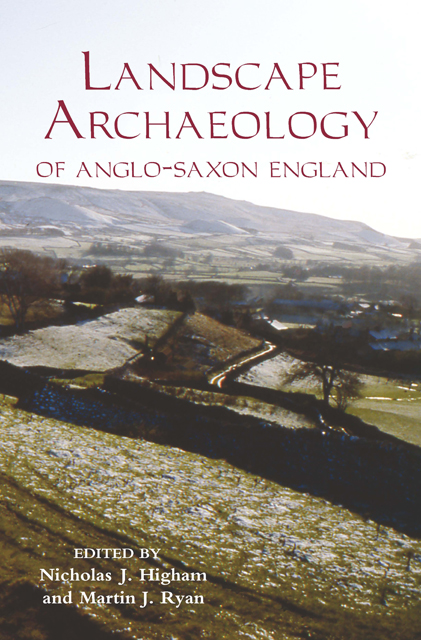Book contents
- Frontmatter
- Contents
- List of Illustrations
- Contributors
- Acknowledgements
- Abbreviations
- 1 The Landscape Archaeology of Anglo-Saxon England: An Introduction
- 2 Barriers to Knowledge: Coppicing and Landscape Usage in the Anglo-Saxon Economy
- 3 Landscape Change during the ‘Long Eighth Century’ in Southern England
- 4 Population Ecology and Multiple Estate Formation: The Evidence from Eastern Kent
- 5 Exploring Black Holes: Recent Investigations in Currently Occupied Rural Settlements in Eastern England
- 6 Medieval Field Systems and Settlement Nucleation: Common or Separate Origins?
- 7 The Environmental Contexts of Anglo-Saxon Settlement
- 8 Calendar Illustration in Anglo-Saxon England: Realities and Fictions of the Anglo-Saxon Landscape
- 9 The Anglo-Saxon Plough: A Detail of the Wheels
- 10 ‘In the Sweat of thy Brow Shalt thou eat Bread’: Cereals and Cereal Production in the Anglo-Saxon Landscape
- 11 The Early Christian Landscape of East Anglia
- 12 The Landscape and Economy of the Anglo-Saxon Coast: New Archaeological Evidence
- Index
2 - Barriers to Knowledge: Coppicing and Landscape Usage in the Anglo-Saxon Economy
Published online by Cambridge University Press: 16 February 2023
- Frontmatter
- Contents
- List of Illustrations
- Contributors
- Acknowledgements
- Abbreviations
- 1 The Landscape Archaeology of Anglo-Saxon England: An Introduction
- 2 Barriers to Knowledge: Coppicing and Landscape Usage in the Anglo-Saxon Economy
- 3 Landscape Change during the ‘Long Eighth Century’ in Southern England
- 4 Population Ecology and Multiple Estate Formation: The Evidence from Eastern Kent
- 5 Exploring Black Holes: Recent Investigations in Currently Occupied Rural Settlements in Eastern England
- 6 Medieval Field Systems and Settlement Nucleation: Common or Separate Origins?
- 7 The Environmental Contexts of Anglo-Saxon Settlement
- 8 Calendar Illustration in Anglo-Saxon England: Realities and Fictions of the Anglo-Saxon Landscape
- 9 The Anglo-Saxon Plough: A Detail of the Wheels
- 10 ‘In the Sweat of thy Brow Shalt thou eat Bread’: Cereals and Cereal Production in the Anglo-Saxon Landscape
- 11 The Early Christian Landscape of East Anglia
- 12 The Landscape and Economy of the Anglo-Saxon Coast: New Archaeological Evidence
- Index
Summary
The purpose of this paper is to explore some of the implications of the use of coppiced wood – hazel, rowan, willow and so forth – for our understanding of the exploitation of the landscape in the Anglo-Saxon period. The discussion is informed by the author's experience in reconstruction archaeology. Much raw data was obtained from experience as Project Director of the Bede's World Museum in Jarrow, and was illuminated and informed by discussion with a number of suppliers of material to the project, notably Jonathan Howe, of Stockbridge, Hampshire, who was largely responsible for bringing coppiced rods to the site in its first three years before more local sources could be found. Initial presentations of this material to a number of local history societies, and particularly in a lecture arranged in 1996 by the now sadly defunct Mayo Abbey Project (in the Republic of Ireland), sparked off some useful reaction and comment, and helped to shape the conclusions presented here. The author is particularly indebted to Joe Brett, of the Mayo Abbey Project, for the chance to share these ideas and find them both challenged and corroborated, all of which has added to the process of refinement. Latterly the opportunity to revisit the findings made at Jarrow has been provided through activity at Butser Ancient Farm, where discussions with Simon Jay, the farm manager, and Steve Dyer have proved extremely fruitful, and of course conversations with delegates at MANCASS in the spring of 2007 afforded further help.
Contemplation of any ‘traditional’ English landscape such as may still be seen all over England reveals a variety of land usage. As well as arable areas under regular cultivation, there are spaces set aside for meadow, bordered with hedgerows, and on steeper slopes or land which is less suitable or not needed for such purposes, woodland is seen – no less managed, and functioning in the medieval period for a multiplicity of uses, including providing pannage for pigs, fuel for heating, cooking and artisan activities, and construction materials of various kinds.
Coppicing – whether from stools or by pollarding – is one of the many activities that may have gone on in such wooded areas in the landscape with such regularity that they were unremarkable – and hence escaped notice in many of the written records (Pl. II.1).
- Type
- Chapter
- Information
- The Landscape Archaeology of Anglo-Saxon England , pp. 23 - 38Publisher: Boydell & BrewerPrint publication year: 2010



